Odette Scharenborg
Objective and Subjective Evaluation of Diffusion-Based Speech Enhancement for Dysarthric Speech
Aug 25, 2025Abstract:Dysarthric speech poses significant challenges for automatic speech recognition (ASR) systems due to its high variability and reduced intelligibility. In this work we explore the use of diffusion models for dysarthric speech enhancement, which is based on the hypothesis that using diffusion-based speech enhancement moves the distribution of dysarthric speech closer to that of typical speech, which could potentially improve dysarthric speech recognition performance. We assess the effect of two diffusion-based and one signal-processing-based speech enhancement algorithms on intelligibility and speech quality of two English dysarthric speech corpora. We applied speech enhancement to both typical and dysarthric speech and evaluate the ASR performance using Whisper-Turbo, and the subjective and objective speech quality of the original and enhanced dysarthric speech. We also fine-tuned Whisper-Turbo on the enhanced speech to assess its impact on recognition performance.
Loudspeaker Beamforming to Enhance Speech Recognition Performance of Voice Driven Applications
Jan 14, 2025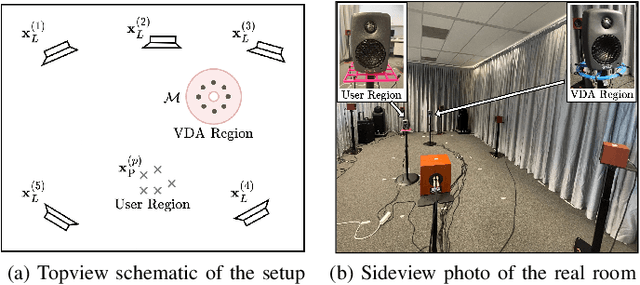
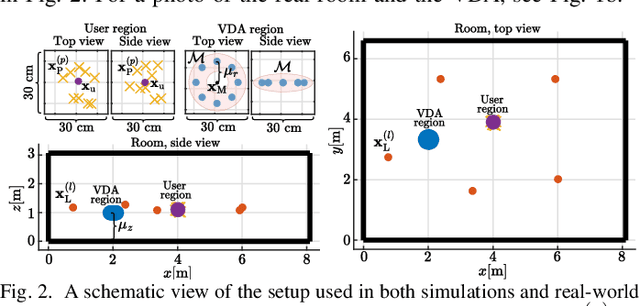


Abstract:In this paper we propose a robust loudspeaker beamforming algorithm which is used to enhance the performance of voice driven applications in scenarios where the loudspeakers introduce the majority of the noise, e.g. when music is playing loudly. The loudspeaker beamformer modifies the loudspeaker playback signals to create a low-acoustic-energy region around the device that implements automatic speech recognition for a voice driven application (VDA). The algorithm utilises a distortion measure based on human auditory perception to limit the distortion perceived by human listeners. Simulations and real-world experiments show that the proposed loudspeaker beamformer improves the speech recognition performance in all tested scenarios. Moreover, the algorithm allows to further reduce the acoustic energy around the VDA device at the expense of reduced objective audio quality at the listener's location.
Good practices for evaluation of machine learning systems
Dec 04, 2024



Abstract:Many development decisions affect the results obtained from ML experiments: training data, features, model architecture, hyperparameters, test data, etc. Among these aspects, arguably the most important design decisions are those that involve the evaluation procedure. This procedure is what determines whether the conclusions drawn from the experiments will or will not generalize to unseen data and whether they will be relevant to the application of interest. If the data is incorrectly selected, the wrong metric is chosen for evaluation or the significance of the comparisons between models is overestimated, conclusions may be misleading or result in suboptimal development decisions. To avoid such problems, the evaluation protocol should be very carefully designed before experimentation starts. In this work we discuss the main aspects involved in the design of the evaluation protocol: data selection, metric selection, and statistical significance. This document is not meant to be an exhaustive tutorial on each of these aspects. Instead, the goal is to explain the main guidelines that should be followed in each case. We include examples taken from the speech processing field, and provide a list of common mistakes related to each aspect.
Self-supervised Speech Representations Still Struggle with African American Vernacular English
Aug 26, 2024

Abstract:Underperformance of ASR systems for speakers of African American Vernacular English (AAVE) and other marginalized language varieties is a well-documented phenomenon, and one that reinforces the stigmatization of these varieties. We investigate whether or not the recent wave of Self-Supervised Learning (SSL) speech models can close the gap in ASR performance between AAVE and Mainstream American English (MAE). We evaluate four SSL models (wav2vec 2.0, HuBERT, WavLM, and XLS-R) on zero-shot Automatic Speech Recognition (ASR) for these two varieties and find that these models perpetuate the bias in performance against AAVE. Additionally, the models have higher word error rates on utterances with more phonological and morphosyntactic features of AAVE. Despite the success of SSL speech models in improving ASR for low resource varieties, SSL pre-training alone may not bridge the gap between AAVE and MAE. Our code is publicly available at https://github.com/cmu-llab/s3m-aave.
As Biased as You Measure: Methodological Pitfalls of Bias Evaluations in Speaker Verification Research
Aug 24, 2024
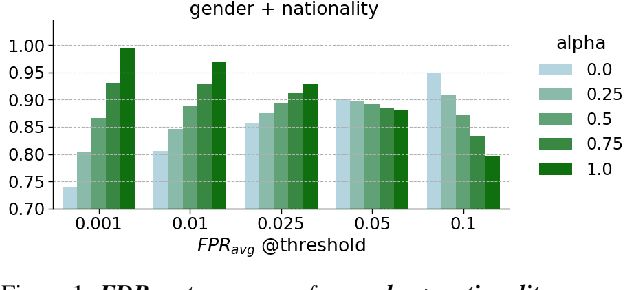
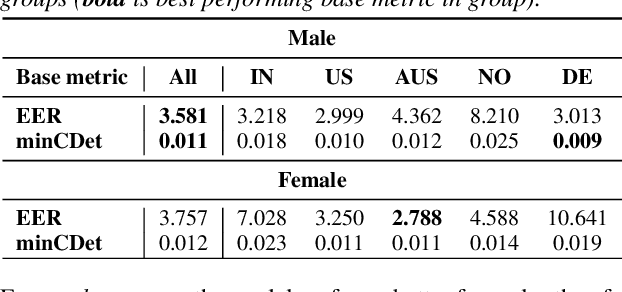
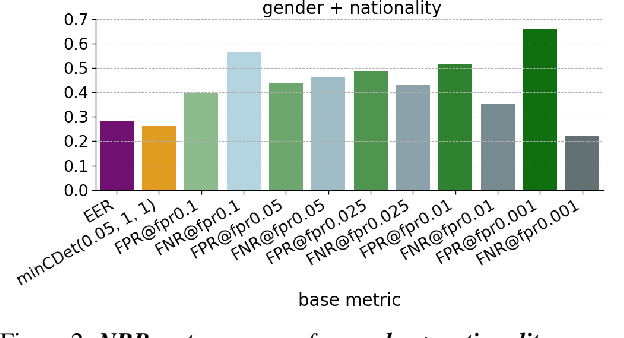
Abstract:Detecting and mitigating bias in speaker verification systems is important, as datasets, processing choices and algorithms can lead to performance differences that systematically favour some groups of people while disadvantaging others. Prior studies have thus measured performance differences across groups to evaluate bias. However, when comparing results across studies, it becomes apparent that they draw contradictory conclusions, hindering progress in this area. In this paper we investigate how measurement impacts the outcomes of bias evaluations. We show empirically that bias evaluations are strongly influenced by base metrics that measure performance, by the choice of ratio or difference-based bias measure, and by the aggregation of bias measures into meta-measures. Based on our findings, we recommend the use of ratio-based bias measures, in particular when the values of base metrics are small, or when base metrics with different orders of magnitude need to be compared.
Improving child speech recognition with augmented child-like speech
Jun 12, 2024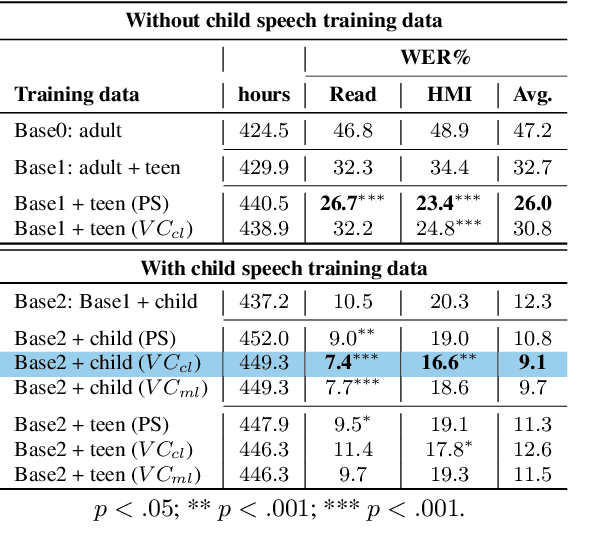
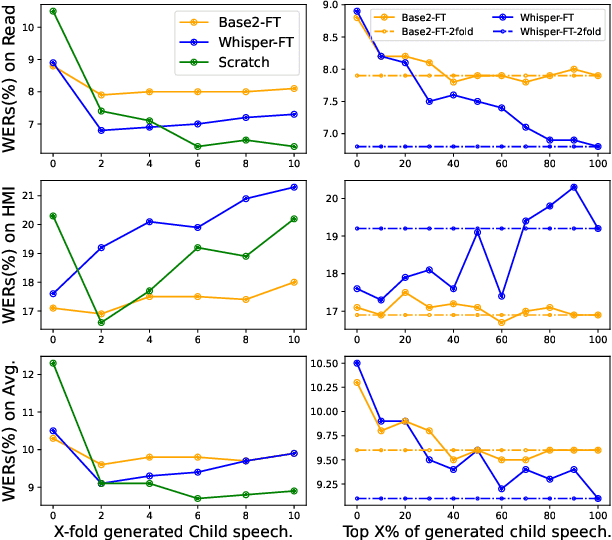
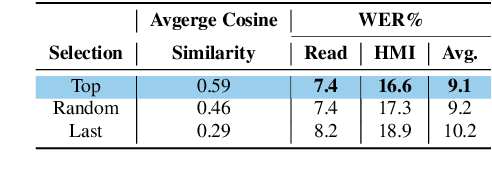
Abstract:State-of-the-art ASRs show suboptimal performance for child speech. The scarcity of child speech limits the development of child speech recognition (CSR). Therefore, we studied child-to-child voice conversion (VC) from existing child speakers in the dataset and additional (new) child speakers via monolingual and cross-lingual (Dutch-to-German) VC, respectively. The results showed that cross-lingual child-to-child VC significantly improved child ASR performance. Experiments on the impact of the quantity of child-to-child cross-lingual VC-generated data on fine-tuning (FT) ASR models gave the best results with two-fold augmentation for our FT-Conformer model and FT-Whisper model which reduced WERs with ~3% absolute compared to the baseline, and with six-fold augmentation for the model trained from scratch, which improved by an absolute 3.6% WER. Moreover, using a small amount of "high-quality" VC-generated data achieved similar results to those of our best-FT models.
Exploring data augmentation in bias mitigation against non-native-accented speech
Dec 24, 2023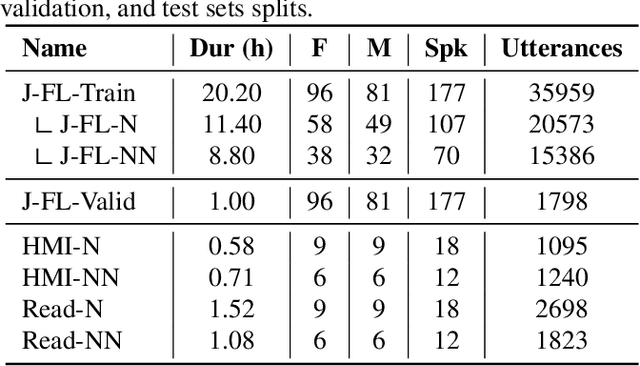

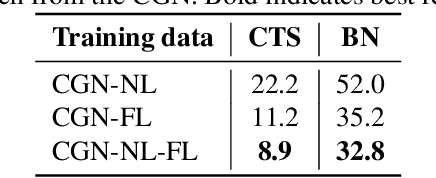
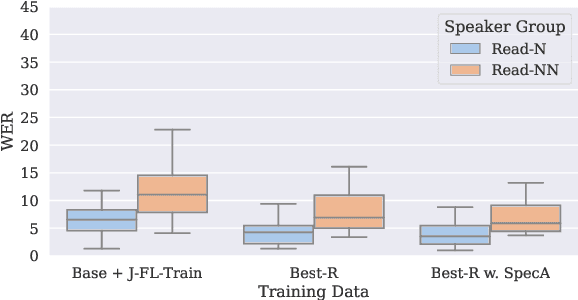
Abstract:Automatic speech recognition (ASR) should serve every speaker, not only the majority ``standard'' speakers of a language. In order to build inclusive ASR, mitigating the bias against speaker groups who speak in a ``non-standard'' or ``diverse'' way is crucial. We aim to mitigate the bias against non-native-accented Flemish in a Flemish ASR system. Since this is a low-resource problem, we investigate the optimal type of data augmentation, i.e., speed/pitch perturbation, cross-lingual voice conversion-based methods, and SpecAugment, applied to both native Flemish and non-native-accented Flemish, for bias mitigation. The results showed that specific types of data augmentation applied to both native and non-native-accented speech improve non-native-accented ASR while applying data augmentation to the non-native-accented speech is more conducive to bias reduction. Combining both gave the largest bias reduction for human-machine interaction (HMI) as well as read-type speech.
Improving Whispered Speech Recognition Performance using Pseudo-whispered based Data Augmentation
Nov 09, 2023



Abstract:Whispering is a distinct form of speech known for its soft, breathy, and hushed characteristics, often used for private communication. The acoustic characteristics of whispered speech differ substantially from normally phonated speech and the scarcity of adequate training data leads to low automatic speech recognition (ASR) performance. To address the data scarcity issue, we use a signal processing-based technique that transforms the spectral characteristics of normal speech to those of pseudo-whispered speech. We augment an End-to-End ASR with pseudo-whispered speech and achieve an 18.2% relative reduction in word error rate for whispered speech compared to the baseline. Results for the individual speaker groups in the wTIMIT database show the best results for US English. Further investigation showed that the lack of glottal information in whispered speech has the largest impact on whispered speech ASR performance.
The Multimodal Information Based Speech Processing (MISP) 2023 Challenge: Audio-Visual Target Speaker Extraction
Sep 15, 2023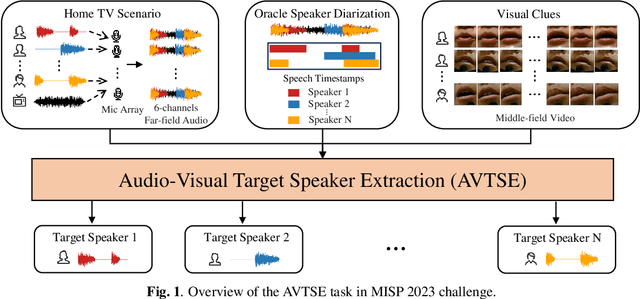

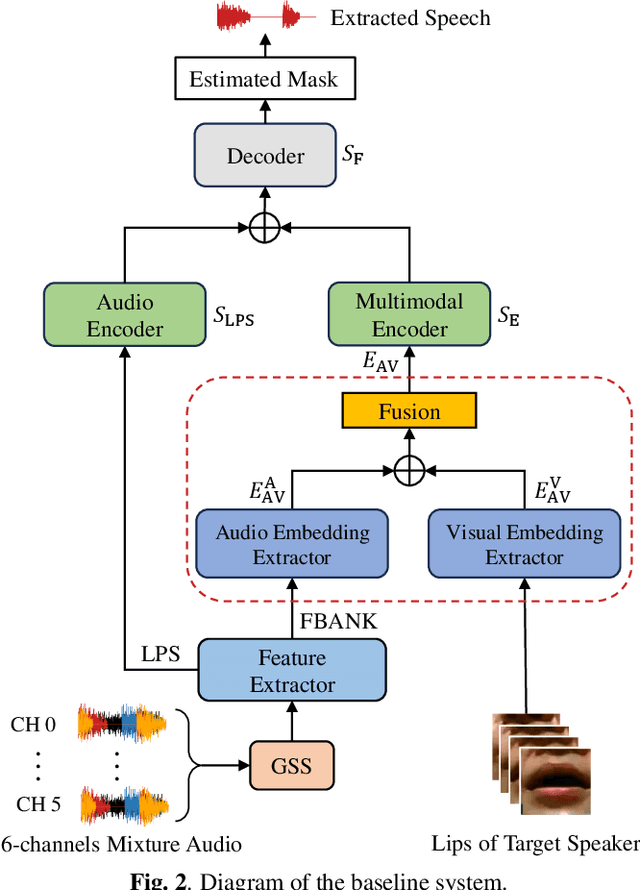

Abstract:Previous Multimodal Information based Speech Processing (MISP) challenges mainly focused on audio-visual speech recognition (AVSR) with commendable success. However, the most advanced back-end recognition systems often hit performance limits due to the complex acoustic environments. This has prompted a shift in focus towards the Audio-Visual Target Speaker Extraction (AVTSE) task for the MISP 2023 challenge in ICASSP 2024 Signal Processing Grand Challenges. Unlike existing audio-visual speech enhance-ment challenges primarily focused on simulation data, the MISP 2023 challenge uniquely explores how front-end speech processing, combined with visual clues, impacts back-end tasks in real-world scenarios. This pioneering effort aims to set the first benchmark for the AVTSE task, offering fresh insights into enhancing the ac-curacy of back-end speech recognition systems through AVTSE in challenging and real acoustic environments. This paper delivers a thorough overview of the task setting, dataset, and baseline system of the MISP 2023 challenge. It also includes an in-depth analysis of the challenges participants may encounter. The experimental results highlight the demanding nature of this task, and we look forward to the innovative solutions participants will bring forward.
Using Data Augmentations and VTLN to Reduce Bias in Dutch End-to-End Speech Recognition Systems
Jul 05, 2023Abstract:Speech technology has improved greatly for norm speakers, i.e., adult native speakers of a language without speech impediments or strong accents. However, non-norm or diverse speaker groups show a distinct performance gap with norm speakers, which we refer to as bias. In this work, we aim to reduce bias against different age groups and non-native speakers of Dutch. For an end-to-end (E2E) ASR system, we use state-of-the-art speed perturbation and spectral augmentation as data augmentation techniques and explore Vocal Tract Length Normalization (VTLN) to normalise for spectral differences due to differences in anatomy. The combination of data augmentation and VTLN reduced the average WER and bias across various diverse speaker groups by 6.9% and 3.9%, respectively. The VTLN model trained on Dutch was also effective in improving performance of Mandarin Chinese child speech, thus, showing generalisability across languages
 Add to Chrome
Add to Chrome Add to Firefox
Add to Firefox Add to Edge
Add to Edge